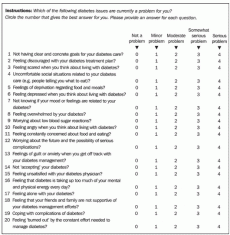Diabetes-Related Emotional Distress
It is common for patients to experience emotional distress from living with diabetes and the impact of its complications. The terms “diabetes burnout” (32) and “diabetes overwhel-mus” (30) have been coined to capture this distress. The types of specific emotional problem faced by type 2 diabetes patients have been reported in several studies (38 - 40). Approximately one third reported “worry about the future and the possibility of diabetes complications” as a serious issue. Other areas endorsed as “serious” by approximately 15% to 20% of patients included:
- Guilt and anxiety at being off-track with treatment
- Scared about living with diabetes
- Not knowing if mood or feelings were related to diabetes
- Being constantly concerned about food and eating
- Feeling deprived around food
- Feeling depressed living with diabetes
The questionnaire used in these surveys is the problem areas in diabetes (PAID) scale (see Fig. 1) (40,41). This is a brief, one-page screening tool that can be used by busy diabetes clinicians to gather information about patient concerns that may affect their self-care behaviors.
It can be given to patients routinely, to screen for overall high emotional distress related to living with type 1 or type 2 diabetes. A total score (overall emotional distress) is generated by simply adding the 0 to 4 values endorsed by the patient for each of the 20 questions in the PAID. This sum is then multiplied by 1.25 to provide a total score of 0 to 100.
A cutoff score of 50 denotes a high level emotional distress that warrants further professional attention. Individual questions scored as “serious” (i.e., scored 4 on a scale of 0 - 4) identify individual areas that a patient finds difficult. These are specific “hot spots” with which the patient is currently struggling emotionally.
For patients scoring high on the total score or individual questions, the clinician might consider investing additional time exploring feelings and practical barriers to good diabetes self-care. It is rare in medical settings for patients to be asked even briefly about their illness-related feelings - despite the great value of this exercise to clinician for patients troubled with the emotional burden of diabetes (30,31).
A key task for the clinician is to give the patient a brief opportunity (i.e., a few minutes) to talk about how he or she feels about living with diabetes. The aim is to talk with the patient about feelings openly and in a safe way (supportive, nonjudgmental). Good listening skills start with open questions, to stimulate the patient to talk about his or her feelings. For example, if a patient scores high on the PAID (above 50), the clinician may say:
It sounds as if you have been feeling overwhelmed with your diabetes care. Could you tell me a little more about how you have felt lately?
Close-ended questions that simply require a “yes” or “no” response tend to close down conversation rather than opening it up. Avoid interrupting at this point, providing information, or showing personal reactions to what the patient has said. Some other suggestions: be aware of your own “mental chatter” and try to simply listen to what the patient is saying when he or she talks. Be aware also of the patient’s body language (tone of voice, facial expressions, use of hands and body posture, pauses and hesitations during difficult moments, etc.). Maintain good eye contact and use small encouraging body signals (nod your head, say “yes, go on” or “hmm” to show you are staying with the patient’s story).
Then briefly summarize what you have heard from the patient both in terms of the specific emotions (e.g., guilt, anxiety, feeling alone, etc.) and the reasons the patient gives for feeling that way. Check with the patient that what you have said is accurate:
If I’ve heard you correctly, you’ve felt ... because ... Does that sound accurate?
Look for a response from the patient that might “fine tune” your summary if needed.
A patient who feels he or she has been heard by an empathic healthcare professional about the emotional distress of living with diabetes, even for a brief period, will feel less distressed and be more motivated to make any behavior changes that may be needed.
Good listening enhances the therapeutic bond between patient and healthcare team member and can be used regularly to good effect in all areas of diabetes management.
 FIGURE 1 Problem areas in diabetes scale. Source: From Ref. 41.
FIGURE 1 Problem areas in diabetes scale. Source: From Ref. 41.
Referral can be made if appropriate to a diabetes nurse educator or other available member of the diabetes clinical team to tackle specific practical issues arising from the emotional concerns identified by the patient (e.g., fear of complications, difficulties with the diet plan). The U.K. Prospective Diabetes Study (UKPDS) (37) has demonstrated the benefit of improved blood glucose control on progression of complications in type 2 diabetes.
Screening for diabetes emotional distress and intervening where a high level of distress is present will support patient self-care efforts that, in turn, will contribute to improved blood glucose control (30).
Recently, the diabetes attitudes, desires, and needs (DAWN) study was launched across 13 countries with the goal to enhance communication between people with diabetes and their healthcare providers using a brief empathic listening intervention (understanding what the patient is saying, thinking, and feeling through open questions, reflective listening, and brief summaries of what was heard) (42).
A focus on understanding the patient’s perspective is an important first step in providing support to the patient experiencing high emotional distress living with diabetes as this strengthens rapport and trust and can help identify the most important issues to focus on from the patient’s perspective.
Garry W. Welch, Alan M. Jacobson, and Katie Weinger
Behavioral and Mental Health Research, Joslin Diabetes Center, Boston, Massachusetts, U.S.A.